By Jeffrey A. Rendall, Photos By Kevin Gaydosh
WHITE SULPHUR SPRINGS, WV – I think you’d agree, many of the world’s greatest artistic creations were solo endeavors. The old saying goes… too many chefs spoil the broth, and that’s probably because they can’t all agree on the recipe.
Art is inspiration, by and large, so if there’s more than one mind going into the creation, there’d need to be a steady level of synthesis amongst all artists to keep the ‘vibe’ going. Would the Sistine Chapel have turned into a jumbled mess if Michelangelo had farmed out parts of it to his assistants? Would the Mona Lisa have become a classic if Leonardo da Vinci had assigned the finishing work to the painter next door?
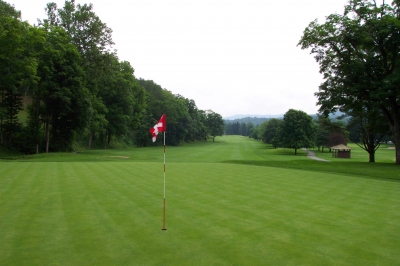 |
| Looking back from the green of the 550-yard, par five 14th hole. |
Golf courses arguably follow the same rationale. If you’re bringing in different influences at various points in a layout’s history, you could end up with something that just won’t sell.
Fortunately for The Meadows Course at The Greenbrier, the compiled work of a few different minds didn’t hurt in the end – and it arguably even helped make the layout what it is today. Though The Meadows really isn’t a ‘collaboration’ of sorts, it certainly offers a set of distinctive looks – and we’re not just talking about the topographical variety found on the land.
Robert Harris, The Greenbrier’s Director of Golf, explains: “The Meadows Course, up until it was redesigned in 1999 by Bob Cupp, was really an uneven jumble of golf design characteristics that didn’t make sense strategically, and as a result it ended up being the step-child or second-tier choice of everyone who stayed here.”
“Then Cupp came in and ironed out all the differences, and now it’s a complete championship golf course that everyone is delighted to play,” Harris said.
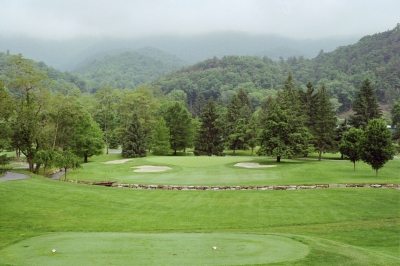 |
| The par three 10th hole is named 'Punchbowl' for a reason. Its' Seth Raynor green will remind you, in case you forget. |
Before Cupp there was a small dose of Seth Raynor (who did the original work on The Greenbrier Course, adjacent to The Meadows), and a big chunk of Dick Wilson (in the early sixties). Then, just last year, Tom Fazio added his name to the hat (will be explained later). Throw in the old classic name of Alex Findlay, and you’ve got a series of personal touches that when combined, could’ve easily cooked up a golf buffet that nobody would want to nibble at.
As briefly as possible, the history of The Meadows reads like this: sometime in the early part of the 20th century, Alex Findlay laid down a nine hole course that became known as The Lakeside Course. Dick Wilson was hired in the late fifties to build a second nine on a farm called ‘The Meadows,’ and the two nines were combined to form the current course under The Meadows name.
Wilson’s construction of the additional holes coincided with the building of The Greenbrier Hotel’s Bunker, as a means of ‘hiding’ some of the vast amounts of soil generated from hollowing out a hill to house the underground Congressional Cold War bomb shelter.
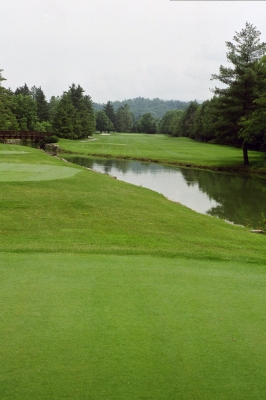 |
| The Meadows' 16th hole is named 'Narrow.' The fence on the right is OB, and there's a creek all down the left side. Narrow, it is. |
At the risk of further confusing you, three of the holes from the old Seth Raynor designed Greenbrier Course were incorporated into the new Wilson inspired Meadows Course, so there’s a Raynor influence that continues to this day in the middle of your round on The Meadows.
Finally, in the late 1990’s Cupp came in to provide some consistency to the golf course, which really had devolved into a series of golf holes that couldn’t be claimed by any one designer, or feature a consistent set of playing qualities.
The Meadows was like a Fresco painting with too many layers of dried plaster. Some of it needed to be chipped away to reveal the vibrant colors underneath.
Harris describes the surgical procedures: “Cupp changed the angles from the tees, rebuilt most of the tees, added fairway bunkers, rebuilt the bunkering around the greens and altered some green shapes without digging up the greens. The work was completed over one winter (and part of a spring), which allowed us to really have a nice, new, polished golf course while avoiding the catastrophic effects of shutting down for a season or two.”
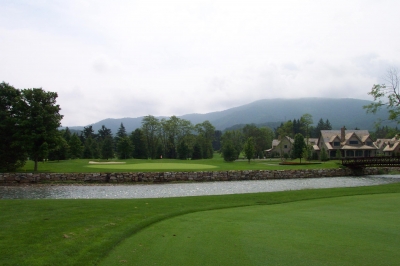 |
| The 404-yard, par four 12th is one of the 'new' Fazio holes. It looks a bit different from most of the Meadows' holes, but it's still very nice to look at. |
“The Meadows doesn’t have the historical significance of The Greenbrier and the Old White courses, but it’s certainly a solid third course for us here at The Greenbrier. It’s a very strong, playable, truly titled championship course, especially from the back sets of tees. People have said that since it now stretches to almost 6,800 yards, it’s the most difficult of our courses here,” Harris added.
It also might claim the mantra of most playable at the same time. Harris said the white tees, which play at 5,784 yards – were specifically designed to provide a gentle trip around for beginning or less proficient players and those who aren’t necessarily looking for a stern challenge.
In other words, the course’s flexibility lies in its ability to play as difficult or easy as you want it.
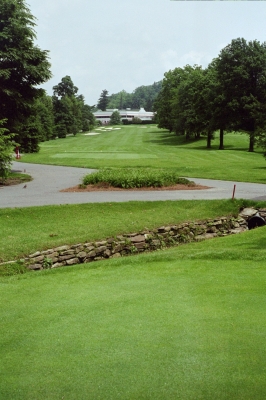 |
| Each of the Greenbrier's three courses' 18th tee leads back towards the clubhouse. Here, it's The Meadows. |
As briefly alluded to above, there’s even a Tom Fazio influence on The Meadows. Again, Harris helps out with the tale: “Bob Cupp built two brand new holes in 1999, on some land out near where the housing is currently being constructed and where The Snead course was added this year (2004). They were two holes with a big lake, really great golf holes that fit with the rest of the property.”
He continues, “But after Cupp did his work, there developed some flood control issues with the new development, mandating that we raise the greens above flood stage – and other laws came into effect at the same time. We couldn’t reproduce the same holes that Bob had done, and Fazio (who was working on The Snead at the time) did his best to build new holes that would blend in with the rest of the golf course.”
As a result, the Meadows offers sixteen re-designed Cupp holes, and two Fazio creations that we described as ‘Snead-like’ in appearance and playability (they’re wide-open with raised greens, similar to those on the Fazio designed ‘The Snead’ for the Greenbrier Sporting Club).
That’s not the only ‘personality’ conflict on the course. Three holes in the middle of The Meadows are still attributed to Seth Raynor – holes eight, nine and ten. You’ll notice the Raynor influence from the rolling nature of the greens, especially on the short, downhill par three tenth hole, named ‘Punchbowl’ for the shape of the putting surface.
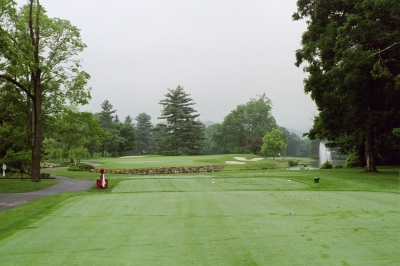 |
| The short par three 2nd hole is probably the hole you'll most remember from The Meadows. With such a tranquil setting, it's hard to forget. |
So The Meadows remains a grand golf collaboration/compilation. Lennon & McCartney (at least in the early days) combined their songwriting talents with The Beatles, and Rogers and Hammerstein put words with orchestrations to produce timeless musicals. So why not combine the talents of several of golf’s notable architects to assemble a compilation of their own?
It wasn’t intentional, but it works. As you’d expect, the course changes gears here and there, but by and large, it’s an old-style journey through a parkland layout, where you’ll need to plan tee shots according to how you want to approach the greens. The putting surfaces are relatively mild compared to the other courses (except on the Raynor holes), but you’ll have to pick your spots to try and take shots away from the course.
Perhaps more than The Greenbrier Course and certainly the Old White Course, you’ll need to hit dead straight tee shots. Fully mature trees line most of the par fours and fives, and add in the thick rough and you’re giving up strokes if you’re not in the short grass. The Cupp added yardage also provides some difficulty, especially on the back nine – with four par fours over 420 yards in length (the back nine is 380 yards longer than the front side).
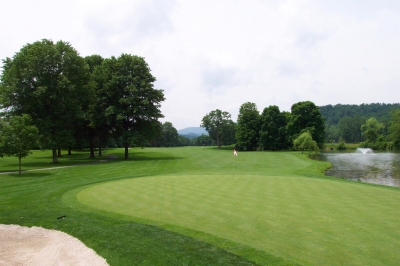 |
| Placement's the key on the par five 17th hole, as it is for every hole on The Meadows. |
As you’d expect from a resort course, the greens are large enough to accept slightly wayward approaches. Just what you’d want from a golf course of this type – you won’t be hunting for golf balls, and you won’t feel beat up – but you probably won’t score quite what you’d hoped for, just from reading the card.
The Meadows is also the most family-friendly course at The Greenbrier, because of its gentle forward sets of tees. That’s a good thing, since the resort offers one of the best all-inclusive golf packages for families, where you won’t have to mortgage the farm to teach the kids how to play.
Harris expounds: “Playing golf at the Greenbrier isn’t inexpensive, but then again, we think you receive excellent value. Our initial fees are substantial ($180 per player), but paying the greens fee entitles you to unlimited golf on any of our courses – so you can play two or even all three of them in one day just by paying an additional cart fee per round ($35).”
All three in one day, wow. But if your hands hold out, why not.
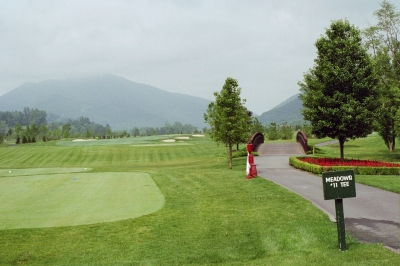 |
| The 11th tee presents a bit of an 'open' breather from the treelined first ten holes. |
Again, as mentioned above, you can bring the kids out in the afternoon, and everyone can play. “You can take your family out after four o’clock for $180,” Harris said. “That includes greens fees, clubs, shoes, golf balls, everything you’ll need to go out and play. And during the summer, you can even get a whole round of golf in before dinner if you want. If you paid for all of it separately – fees, shoes, club rental, etc…, you’d need more than a piece of the rock, you’d need the whole mountain.”
That’s a heckuva deal, if you think about it.
Highlights on The Meadows include the second hole, a pretty straightforward 188-yard par three – but it’s also the hole you’ll best remember from the course, because of a pond you’ll have to carry fronted by a rock wall. One of the most beautiful holes at The Greenbrier.
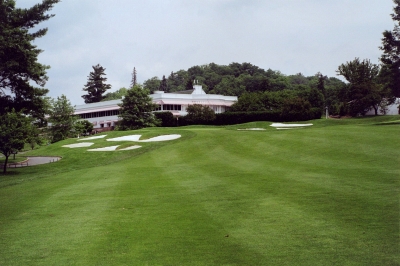 |
| The final approach shot of the round to the double green of the 18th. Huge green, big bunkers, you won't get off easy. |
Moving ahead to eight, it’s the first of the Seth Raynor holes. 416 yards in length, and again, pretty straightforward, you’ll certainly remember its unique green – it’s severely sloped from back to front, and sits at an angle. Very old-style and challenging.
Another classic Raynor hole is the tenth hole, a 179-yard, downhill par three fronted by a stream and another rock wall. Because of the ‘punchbowl’ shape of the green, there’ll be some challenging pin placements – making it play much tougher than the short yardage would indicate.
The closing sequence is interesting and challenging, starting with the 430-yard sixteenth, appropriately named ‘Narrow.’ For a hole of this length, there doesn’t appear to be much room to drive the ball, as there’s an out-of-bounds fence to the right, and a stream all down the left side.
Seventeen is a strategically designed par five with a green perched on the lake, called ‘Lakeside.’ Eighteen finishes up with a very difficult, uphill 433-yard par four that shares its green with the adjacent eighteenth hole on The Greenbrier Course. The green surface is huge, and well bunkered on all sides.
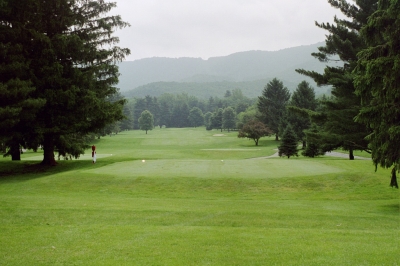 |
| It's a narrow chute off the tee of the par five 7th hole. |
As a final note, the mountain views on The Meadows Course are probably the finest you’ll get from playing golf at The Greenbrier. Because it lies in the valley (as opposed to along the two ridge lines, like the other two courses), you’ll see the entire panorama. The views add just that much more to a golf course that has many different personalities – which just proves that a grand synthesis of golf architectural talent can turn out okay, after all.
Details:
The Meadows at The Greenbrier
Phone: (800) 453-4858; FAX: (304) 536-7872
Website: www.greenbrier.com
Course Designers: Alex Findlay, Dick Wilson, Seth Raynor, Tom Fazio, …?
Director of Golf: Robert Harris
Head Golf Professional: Hill Herrick, Jr.
Tees/Yardage/Slope/Rating
Gold 6776 129/72.8
Blue 6342 124/70.3
White 5784 121/67.8 128/73.6 (L)
Red 4979 114/68.2 (L)
Rates
$180 per day for all three Greenbrier Resort courses, includes golf cart. Replays available for an additional $35 for cart fee. Greens fee is good for the whole day, on all courses.
Walking is allowed anytime, with a $35 credit for the golf cart.
Caddies are available. No pull carts.
Fees include unlimited range privileges, all day after paying fee.
Several packages available including golf, meals and accommodations at The Greenbrier. Consult the website for more information.
| Related Links | Comments on this article? | |
|
Maryland National Golf Club Hollow Creek Golf Club Rocky Gap Resort PB Dye Golf Club in Ijamsville Whiskey Creek Golf Club |
E-mail Jeff Rendall, Editor: jrendall@golftheunitedstates.com |












